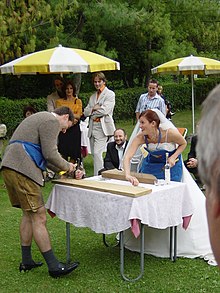Hammerschlagen

Wettnageln or Nagelbalken (German for competitive nailing) is a sport in which participants compete against each other to drive nails into a wooden plank or shape.
Craftsmen in German-speaking countries have driven nails into certain wooden shapes for luck for centuries, as in the case of the Stock im Eisen in Vienna. The use of this to a popular contest of skill is known since the First World War, during which it was introduced as a means of gathering donations for war-time charities, in the form of Nail Men. The current use is just for leisure and as a game at events and festivals, often for children and as a wedding custom.
History
According to Florian Dering, a museologist at the Munich Stadtmuseum nailing competitions as fun events are known since the 1920s.[1] They are used by showmen and charities to raise money and also at weddings, to have the newly married couple show their skills to the audience.
Dering reports a series of administrative regulations: the plank should have no protruding branches, the hammer should have a weight of at least 400 g and the nails provided should be round, at least one inch long and flat-headed.
Competitive nailing can be a solo game, for example at fairs, where driving the nail home in one to three blows wins a small prize, or as a contest between individuals or teams.
For Expo 2000, the Bundesanstalt für Arbeitsschutz und Arbeitsmedizin in Dortmund provided an exhibition DASA – Arbeitswelt Ausstellung to show different aspects of workplace security.[2] A Nagelbalken area was designed as a central display to demonstrate physical skills, security measures and risks.[3]
Further reading
- Wulf, Christoph; Althans, Birgit; Audehm, Kathrin; Bausch, Constanze; Jörissen, Benjamin; Göhlich, Michael; Zirfas, Jörg (2004). Bildung Im Ritual: Schule, Familie, Jugend, Medien. VS Verlag für Sozialw. p. 75. ISBN 978-3-8100-4090-9.
External links
- Helge Normann, "Das Geheimnis des Nagelbalkens", Wochenspiegel, 26 June 2010 (with video) Template:De icon
- Postenzettel (scorecard) for a Nagelbalken contest (PDF) Template:De icon
References
- ^ Dering, Florian (1986). Volksbelustigungen: eine bildreiche Kulturgeschichte von den Fahr-, Belustigungs- und Geschicklichkeitsgeschäften der Schausteller vom 18. Jahrhundert bis zur Gegenwart. F. Greno. ISBN 978-3-89190-005-5.
- ^ Gerhard Kilger, "Das szenografische Konzept der DASA", in: DASA – Arbeitswelt Ausstellung, Kolloquium 2000: Szenografie in Ausstellungen und Museen (pdf) Template:De icon
- ^ Kilger, Gerhard; Bieneck, Hans-Jürgen (2002). Neue Qualitèat der Arbeit: wie wir morgen arbeiten werden. Campus Verlag. p. 41. ISBN 978-3-593-37161-0.
